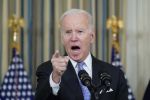US Fed slashes dividend plans of large Wall Street banks
Goldman Sachs, Morgan Stanley and JPMorgan Chase & Co, all with large and risky trading operations, lowered their ambitions for dividends and share buybacks, the Fed said on Wednesday, to keep them robust enough to withstand a hypothetical financial crisis. The revised plans allowed them to pass the Fed's simulation of a severe recession.
But the Fed rejected plans for the U.S. units of Deutsche Bank and Santander, in line with earlier media reports.
The objection came even though both banks satisfied the Fed's minimum capital requirements, since there were "widespread and substantial weaknesses across their capital planning processes," the Fed said.
Citigroup, whose Chief Executive Mike Corbat has staked his job on not failing the so-called stress tests again, will sigh a breath of relief as it passed this year's tests, so that it can raise its payouts after it failed last year for the second time in three years.
Bank of America scraped by, as the Fed approved its payout plans, but said it had to get a better grip on its internal controls and its data models.
"Bank of America exhibited deficiencies in its capital planning process.... in certain aspects of (its) loss and revenue modeling practices," the Fed said.
The Fed first started running its so-called stress tests in 2009, when many of the largest U.S. banks were struggling to repay taxpayer bailout funds they took after the collapse of Lehman Brothers a year earlier.
The failure of four of the largest U.S. banks to win unconditional approval on their first attempt underscores the deep divide between Wall Street banks and their regulators over whether the lenders have enough capital on their books to weather another crisis.
In a sign that the largest banks have boosted capital buffers significantly in recent years, all 31 banks tested stayed above the minimum levels, passing the first leg of the Fed's annual exam last week.
But the second part of the test, which determines whether banks can go ahead with their planned shareholder payouts, has proved more challenging, in part because the Fed weighs "qualitative" factors, such as whether banks have good systems for identifying and preparing for risks.
The tests are an increasingly important tool for the central bank, which is also the country's leading bank regulator, and allows it to look under the hood of the banks, which critics say are "too large to manage".
In last week's capital tests, banks with a large Wall Street presence such as Goldman Sachs, Morgan Stanley and JPMorgan Chase & Co were among the five banks with the lowest readings on the capital chart.
The failure of the two foreign-owned U.S. bank holding companies could also signal a tough time ahead for more foreign banks expected to join the Fed's annual examination in coming years, such as the U.S. units of Credit Suisse, Barclays and UBS. Only seven foreign-owned banks took part in the tests this year.




Комментарии